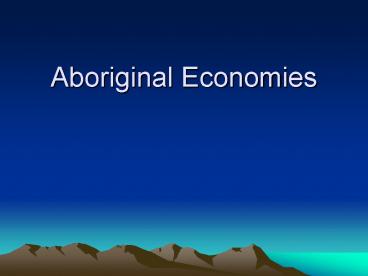Aboriginal Economies - PowerPoint PPT Presentation
1 / 17
Title:
Aboriginal Economies
Description:
Aboriginal Economies Aboriginal Technologies The common stereotype is aboriginal societies were primitive and did not have any technology. This is not true. – PowerPoint PPT presentation
Number of Views:238
Avg rating:3.0/5.0
Title: Aboriginal Economies
1
Aboriginal Economies
2
Aboriginal Technologies
- The common stereotype is aboriginal societies
were primitive and did not have any technology. - This is not true. Aboriginals had a different
way of life and had a view of nature that was
very different than the European view. - There was no money or individual wealth.
- They respected the environment. People were no
more important than a bear or tree.
3
- Aboriginals had a very advanced knowledge of
plant science that would later have a great
impact on food development and medicine
throughout the world. - 60 percent of the worlds crops today were
originally cultivated by aboriginal peoples.
4
- Crops such as potatoes, corn, peppers, and
tomatoes instigated a revolution in agriculture. - People had more variety in their diets which made
meals more balanced and nutritious which in turn
increased the population of the world.
5
- Aboriginals also developed sophisticated stone
tool technologies and methods of transportation
that were ideally suited for their environment.
6
- Aboriginal economies were shaped primarily by the
landscape and climate of their land. - If their land had rivers they developed canoes.
- If there were large mammals such as caribou, they
developed hunting tools for them.
7
Farming Technologies
- Aboriginals provided Europeans with many new
crops through trade, developed sustainable
farming techniques, and demonstrated advanced
food preservation techniques. - European agriculture was focused on animal
farming.
8
Corn
- Through careful observation and genetic selection
aboriginals developed many varieties of corn such
as sweet corn, dent corn, and flint corn. - They developed grinding and drying technologies
that preserved food while keeping its
nutritional value.
9
- They also learned how to harvest wild food such
as turnip, rice, and berries in ways that
sustained their perpetual growth.
10
The First Farmers
- The Haudenosaunee (Iroquois) are considered the
first farmers. - They were located in the fertile region of the
St. Lawrence Lowlands. - Farming resulted in the Iroquois having one of
the highest population densities in North
America.
11
- Women were responsible for harvesting and raising
crops which gave them an elevated status within
their society. - Crops were harvested using hoes made from moose
antlers and the shoulder blades of deer. - Beans and corn were stored in chests of bark and
squash was stored underground.
12
Medical Technologies
- At the time of contact, aboriginal medicines
focused on healing both body and mind. - They became the basis of modern western
pharmacology. - Over 500 drugs in use today originated in
aboriginal societies. - The Wendat tribe saved Jacques Cartier's men from
scurvy by developing a drink from birch bark
which was rich in vitamin C.
13
Trade Economies
- There is a great variety of resources in North
America. - These were extensively traded between aboriginal
groups. - Vast networks were set up this was evident in
artifacts from Labrador being found in the St.
Lawrence lowlands.
14
- Most commonly traded tools included arrowheads,
tools and shells. - The mineral obsidian was also very important in
creating hunting tools. - Shells were used on clothing to symbolize
importance within a tribe.
15
Transportation Technologies
- Another important Aboriginal invention is the
canoe. - This was very important to the development of
Canada as a Nation. - It allowed for the discovery of the interior of
the land. - Trade was only made possible because of the
canoe.
16
Wealth and Social Standing
- Wealth had a very different definition compared
to our society. - Wealth was valued by spiritual powers and good
relationships. - Material possessions were valued but only for the
prestige associated with giving them away at
ceremonies.
17
The Potlatch
- In the Pacific coast societies, sharing of wealth
was evident in a ceremony called Potlatch. - This was a feast in which the host family shared
its wealth with poorer members of the
communities. - Gifts of food, artwork, and slaves were given
away.































